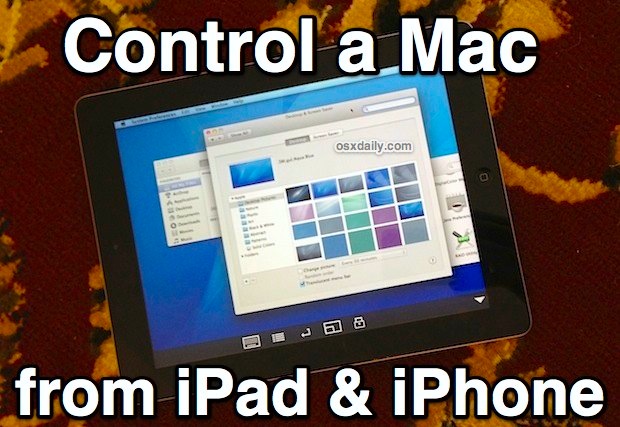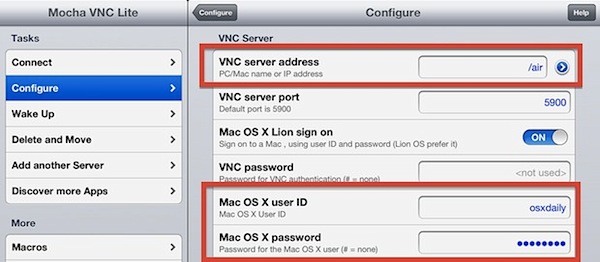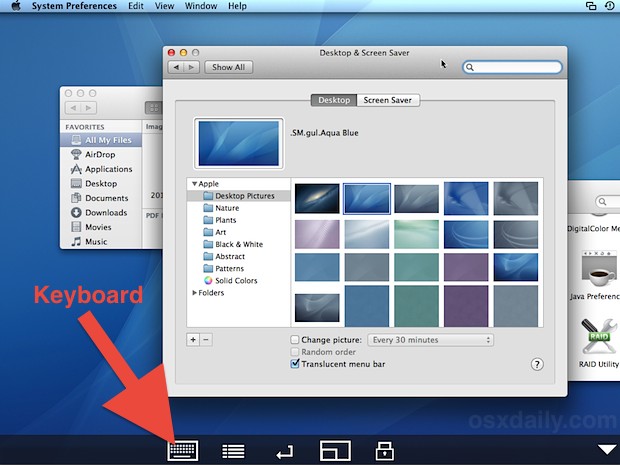How to VNC from iPad or iPhone to Mac for Easy Remote Access

Following up about Screen Sharing in Mac OS X, which lets you remote control a Mac from another Mac, you can also remotely access and control Macs from an iPhone, iPad, or iPod touch using VNC.
There is minimal work involved to get this working, and if you already set up Screen Sharing you’re halfway there. A variety of paid solutions offer the same abilities described here, but we’ll show you how to do this completely for free and have it working in just a minute or two.
How to Remotely Access a Mac from iPhone / iPad with VNC
- First things first, turn on Screen Sharing on the Mac if you haven’t done so by going to the Apple menu > System Preferences > Sharing and checking the box for “Screen Sharing”
- From the iPhone, iPad, or iPod touch, you’ll need a VNC client, like VNC Viewer, or Mocha VNC Lite, from the App Store (both are free VNC clients, we’re using Mocha for the article here)
- Launch the VNC client app in iOS and tap “Configure”
- Look for “VNC server address” and tap the (>) blue arrow button to locate a local Mac, or enter the IP address of the Mac to connect to
- Look for “Mac OS X user ID” and enter the login ID, then enter the password in the field below
- Now back to the main Mocha VNC menu and tap “Connect” to connect to the Mac just configured
- A gray screen saying “Connecting” will appear before the VNC session is established, in a moment the iPhone, iPad, or iPod touch will gain control over the Mac screen

Now you’re remotely connected to the Mac, right from the iPhone or iPad.
Controlling the Mac can be done with tapping, touch, tap and hold, and other mostly obvious gestures.
Summon a keyboard to work on the Mac by tapping the keyboard icon in the Mocha VNC menu bar.

How usable the remote screen sharing is going to depend significantly on connection speeds, and any connection over a LAN or high speed broadband will be much more usable than a connection from an iPhone or iPad out on a 3G connection trying to VNC back home. Also, Mac OS X is a desktop OS and obviously not built for touch, so it can be a bit clunky to attempt anything too serious with the controls as is.
Finally, a potential hiccup if you want to remotely access the Mac from the outside world comes with firewalls and routers, each of which may block the VNC ports 5900 and 5800 from the outside world. Because of the wide variety of routers out there, allowing forwarding to those ports is beyond the scope of this walkthrough, but you should be able to do it quickly yourself. The port forwarding issue will not impact connections made on the local network, and some routers will automatically forward the port by default making this a nonissue.
Do you use VNC or remote desktop to access a Mac remotely with an iPhone or iPad? What do you think of this feature? Do you have an alternative? Let us know your experiences and thoughts in the comments.


Typing the exclamation character on iOS comes across as a 1 on the Mac.
You may try R-HUB remote support server iOS app for remotely accessing MAC from an iPhone or a iPad.
I use Rowmote pro and its much easier to set up to control a mac. I use it when connected to my tv.
I tried Mocha VNC Lite before, and the BIG issue with that is there is no access to Control, Command, or Option keys without upgrading to the full client. It’s interesting as a “can I do this?” type of thing, but useless for actually, you know, CONTROLLING your desktop machine.
I’ve found two better options for quick and dirty VNC access to your Mac.
1. PocketCloud Remote Desktop – Free version is limited in that you can only create one configuration (in other words, connect only to one computer). In order to access a different computer, you need to reconfigure the connection entry (change the host name). Aside from that, you have full functionality. Biggest issue I’ve found is that it occasionally drops the connection.
2. LogMeIn – (I see an ad for this on the page with the article…!) This requires a server portion to be installed on your Mac, but the benefit is that once it’s installed, you can access your desktop through the Internet without having to know your IP address or have a DNS name to connect to. The basic client and server seem to be free and I’m not aware of any real limitations on it. My biggest issue with this is that the “mouse pointer” seems to be funky; I’m constantly positioning it wrong, but that could be my fat fingers or something.
Both of these options give you better remote access than the Mocha VNC Lite app suggested in this article, and both are free, and if you wish to reimburse the developers, you can always pay for the full client when you’ve settled on one.
An additional Tip: Set your Mac’s display to 1024×768 (iPad2) or 1280×1024, no more.
If you know your going to be using your Mac this way remotely often, I suggest getting in the habit of dropping your home computers screen resolution. People are going to cringe, but 1024×768 will make for a snappier screen update then 2880×1800. Even 1280×1024 or there abouts would be better.
Keep in mind that what’s getting sent is basically a stream of compressed Jepg images. The smaller those images are more you can send/receive and the faster your remote screens display will refresh.
An alternative is to set up your Mac to provide a VPN (may require extra software or adding the Mac Server facilities to it – quite cheap from the App store) and connecting the iPad/iPhone via the VPN. There’s more security that way as you have to authenticate onto the network properly rather than just connecting a VNC session.
This is very usefull and simpel! Just what I was looking for. I have an iBook G4 running Home Automation software to control our light via X10. As the iBook has a 4:3 screen, this fits perfectly on the iPad screen! Now I can control it from the couch i.s.o the basement.
How do you switch between full screen applications??
When I clicked Screen Sharing in SP I got an exclamation mark and text saying “Screen Sharing is currently being controlled by the Remote Management service.” What’s up with that?
First, are you the Admin for your computer? If not you need to contact your admin and get their help with this.
If not look down the list further and check to see if Remote Management is checked. There are two ways to handle remote access on Macs, Screen Sharing and Remote Management. Remote Management is more robust and intend to be used with Apple Remote Desktop and Apple Server management.
Again if you are not the admin and Remote Management is checked. Just click on it to highlight it and look at the “Allow access for:”. If you don’t see your name click the + button and add your user ID from the list. Click on options and make sure Observer and Control are at least clicked. Now that most “VNC” Apps for iOS are able to use MacOSX user IDs as the login you don’t need to go to the Computer Settings button and add a VNC password there. Just follow the steps in the guide above as normal.
I would be more interested in the reverse. Accessing an iPad screen from a Mac, as in monitoring the Kids.
YES! So much, this! This is and so many other remote management options are desperately needed to make iPads really truly viable for school settings.
If anyone reading this gets close to an Apple Dev, please please please yack their ear off about this topic. I can get any iOS device without an A5 chip or better having issues not being able to do this, but anything that can handle AirPlay should be able to. If an A5X can push a retina screen it can send a sequence shrunk and compressed images over the network to an Admin computer.
In a home or school networked environment no one is going to care about a bit of battery loss from the nearly always live connection. We who have the dubious task of monitoring children (be us parents or teachers) need every last tool we can get.
It doesn’t even need to be the full quality of the screen, it could be compressed and the overall resolution shrunk before being transmitted. I would love to be able to keep a classroom set of 20 to 30 iPads on rotating display through Apple Remote Desktop.
How do you connect to your Mac w/Mocha when it falls asleep?
When it falls asleep it cannot be awaken remotely….
Use WOL
Could you clarify? I have indeed seen that option on the app but how does it work?
Make sure your Mac is connected to your router by an Ethernet cable (not Wireless). Then go into Energy Saver and check “Wake for Ethernet network Access.”
You may also need to dig into your VNC client app and see if they have a setting for WOL, which will likely need your computer’s MAC address.
It is possible if you have a newer Mac it supports WOL over WiFi… but I’ve found that flakey and unreliable personally.
It really sucks that screen sharing and file sharing is not core functionality for an iPad. An iPhone I can see not needing this function, but the iPad is more computer and less phone.
Thank you for the info! Can’t believe how simple it is to access my computer remotely.
I’ve never had a consumer class router block VNC ports. Connecting from an iPhone is more novelty than useful though is it not? iPad, sure, iPhone? No way.
Used to do this on my iPod Touch 3rd gen with iTeleportConnect (a more expensive option). It’s actually what got me saying, “a bigger screened iPod Touch? Yep I’d be totally down for that, don’t know why ya’ll people are saying Apple will never make one and that it’s pointless.”
Although I’m not sure Mocha is the right choice if you want to use an iPhone. You need one that uses a fake mouse pad mode rather then a touch based one.